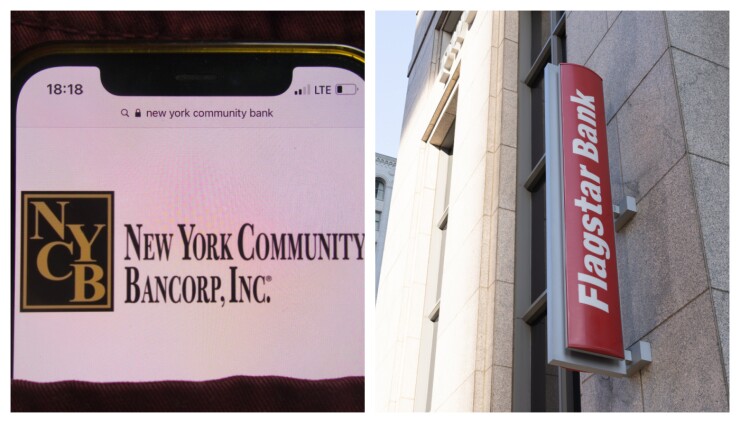New York Community Bancorp is slashing part of its newly acquired mortgage business in an effort to cut costs during what's expected to be another challenging year for mortgage lending.
The Long Island-based company, which
New York Community expects to incur $12 million to $13 million in one-time restructuring costs — mostly in the form of severance pay, but also as a result of early terminations of lease and vendor agreements, executives said during the company's fourth-quarter earnings call.

Last year, before the deal closed, Flagstar cut mortgage costs as loan originations slowed in a rising rate environment. Those moves included trimming the Troy, Michigan, company's mortgage workforce by 7% at the end of the third quarter.
While Flagstar made attempts to rightsize the business, those efforts turned out to not be enough, given the gloomy outlook for the mortgage industry, New York Community CEO Thomas Cangemi said on the call. Annual origination volume is expected to fall 25% in 2023 after dropping 46% last year, he said.
"They've been cutting and cutting and cutting [but] at the end of the day, we … wanted to make sure that this business is not losing any money," Cangemi said. "We're not going to be losing money in the current environment.
"The goal here was not to bleed," he added.
New York Community's restructuring announcement follows reports by
On Tuesday, a New York Community spokesperson did not immediately respond to questions seeking additional details about the cuts. Flagstar's website lists 94 home loan centers, including in states such as Massachusetts, Connecticut, North Carolina, Illinois, Colorado and Washington that have no Flagstar or New York Community branches.
Together, New York Community and Flagstar operate 395 branches in nine states — New York, New Jersey, Michigan, Florida, Wisconsin, Ohio, Indiana, California and Arizona.
New York Community is one of several banks making changes to its mortgage business as higher rates have slowed borrower demand. Wells Fargo, one of the most active mortgage lenders in the nation,
Citigroup
Earlier this month, North American Savings Bank in Kansas City, Missouri, said it would
New York Community's Cangemi said that making "these types of significant restructuring efforts" was a "difficult decision," but he argued that there will be a silver lining when mortgage activity rebounds.
"With this magnitude of the business and our presence, we have an opportunity to really drive revenue at the appropriate time if there's a resurgence … in the mortgage business," he said.
The $2.6 billion acquisition of Flagstar is the largest deal in New York Community's history. It was announced in April 2021 and was originally expected to close during the fourth quarter of that year, but it wound up being extended twice as the two companies awaited regulatory approval and
Now that the merger is complete, New York Community Bancorp will remain the parent company, while the banking subsidiary will be known as Flagstar. Executives have said the Flagstar name better reflects the company's expanded geography.
In early 2024, all nine bank brands that currently operate under the New York Community umbrella are to be rebranded as Flagstar.
Excluding mortgage restructuring expenses, the company is still aiming to achieve $125 million in cost savings as a result of the acquisition. About half of that total is expected to show up this year, Cangemi said.
A major goal of the acquisition was to transform New York Community, which historically has operated as a thrift, into a traditional commercial bank with fuller banking relationships, a lower-cost deposit base and a more diversified loan portfolio.
During the fourth quarter, non-interest-bearing deposits rose to 21% of total deposits, up from 9% in the prior quarter, largely because of the addition of Flagstar. On the loan side, New York Community's long-standing multifamily lending portfolio shrank to 55.3% of total loans, down from 76% in the third quarter, as a result of the Flagstar deal.
Commercial and industrial loans grew to 17.8% of the company's loan portfolio, up from 10% the previous quarter.






